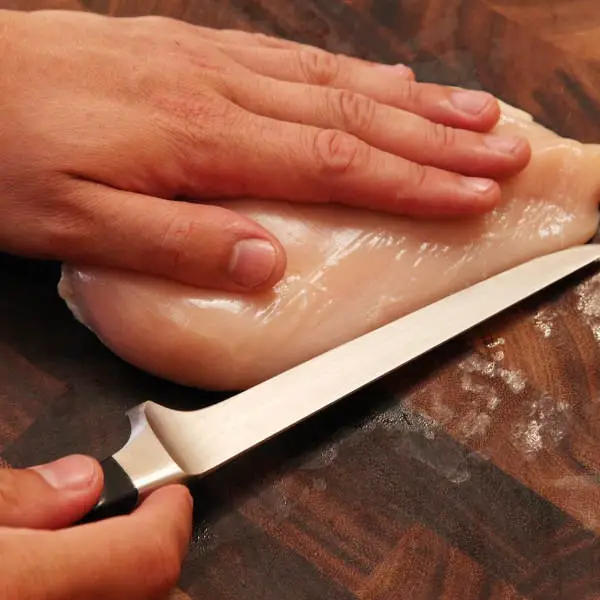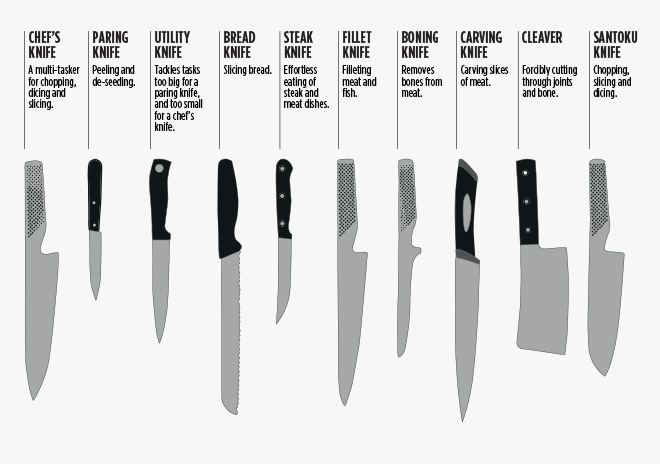Cutting raw chicken can be a daunting task, but with the right knife it can be easily accomplished. When selecting a knife to cut raw chicken, you should consider the size and weight of the knife as well as the type of blade. A smaller, lighter knife is easier to control and will allow you to make more precise cuts.
A serrated blade is also a good option for cutting raw chicken as it will help you avoid crushing the meat.
If you’re cutting raw chicken, it’s important to choose the right knife. A dull knife can not only make the job more difficult, but it can also be dangerous. A sharp knife is less likely to slip and cause injury.
There are many different types of knives that can be used to cut raw chicken. A chef’s knife is a good option because it’s designed for chopping and slicing. It has a broad, heavy blade that can handle tough meat.
If you don’t have a chef’s knife, you can also use a boning knife or a utility knife.
When cutting raw chicken, it’s important to use a cutting board. Chicken contains bacteria that can contaminate other food, so it’s important to keep it separate from other ingredients.
Use a clean cutting board that is large enough to fit the chicken pieces without overcrowding them. Place the chicken on the cutting board skin-side down and position your hand so that your fingers are curled under and your thumb is on top of the blade. Using a sawing motion, slice through the meat with long, even strokes.
Once you’ve cut up all of the chicken, be sure to wash your hands thoroughly with soap and water.
Knife Selection and Cutting Raw Meat
How Do You Easily Cut Up Raw Chicken?
Properly cutting up raw chicken can be easy if you have the right tools and know-how.
First, make sure you have a sharp knife. A dull knife will not only make the job more difficult, but can also be dangerous.
Second, it’s important to have a clean cutting board. A dirty board can harbor bacteria that can contaminate your food.
Third, cut chicken against the grain for the best results.
Fourth, when cutting boneless chicken breasts, use a fork to hold the meat steady while you cut.
Finally, don’t forget to wash your hands thoroughly after handling raw chicken. Now that you know the basics, let’s get started!
To begin, place the chicken breast on your cutting board with the skin side down. Using your sharp knife, slicing vertically along one side of the breastbone (the long white bone that runs down the center). Continue slicing until you’ve cut through the entire breast.
You should now have two boneless chicken halves. Next, take one of those halves and place it flat on your cutting board with the skin side up.
Find the thin line of connective tissue that runs down its center and slice through it horizontally to butterfly or halve each half breast (this will make them cook more evenly).
Now you should have four thinner pieces of boneless chicken total. If desired at this point you can remove any excess fat or skin from these pieces using a paring knife – though this is optional depending on how lean you like your poultry cuts to be.
Finally, we’ll need to cut these large pieces into smaller strips or cubes suitable for cooking as part of a dish or recipe.
For strips ideal for stir-fries or fajitas: holding one piece of meat steady with a fork (skin side up), slice vertically downwards into even strips about 1-inch wide; then turn your chopping board 90 degrees and slice across those strips horizontally into smaller cubes if desired – but again this is optional and personal preference will dictate what size cuts are best for your needs here!
If making cubes for kabobs or soup: simply slice each larger piece first into horizontal strips as described above; then turn your choppingboard 45 degrees so that stripes are running diagonally across it;
then proceed to chop downwards into even square chunks – again aiming for around 1-inch thickness but ultimately letting personal preference be your guide here in terms of bite-size final product!
How Do You Cut a Chicken With a Knife?
There are a few different ways that you can cut a chicken with a knife. One way is to first Cut the chicken into quarters. To do this, start by cutting off the legs at the thigh joint.
Then, cut through the breast meat and remove the wings. Finally, cut the quarters in half through the breast bone. Another way to cut a chicken is to first remove the breasts.
To do this, make a lengthwise cut along each side of the breastbone, then follow the contour of the breast to remove it from the carcass. Once you have removed both breasts, you can then quarter or butterfly the chicken as desired.
Finally, you can also de bone a whole chicken if you want to make things easier on yourself.
To do this, start by removing all of the skin from the chicken. Then, using a sharp knife, carefully remove the meat from the bones starting at the joints. You will be left with a boneless and skinless chicken that you can then slice or dice as needed.
How Do You Cut Raw Chicken Breast?
Assuming you would like tips on cutting raw chicken breast: It is important to have a sharp knife when cutting chicken as it will make the process easier and less likely to cause accidents.
First, cut the chicken breast in half crosswise so that you have two thinner pieces. Then, place each piece skin-side down on a cutting board.
To remove the tender from the breast, make a lengthwise cut along one side of the white line that runs down the center of the chicken-breast. Next, turn the chicken over and cut it into thin strips going against the grain.
Finally, cut each strip into smaller pieces if desired.
What Do You Use to Cut a Chicken?
When it comes to cutting a chicken, there are a few different tools that you can use. First, you could use a sharp knife. This is probably the most common option and it will work just fine.
However, if you want to make things a little easier on yourself, you could also use a pair of kitchen scissors. Just be sure that they are very sharp so that you can get through the chicken easily.
Another option is to use an electric knife.
This is definitely the easiest way to go, but it does require an extra step of setting up and plugging in the knife. If you have one available, though, it will make quick work of cutting up a chicken.
So, those are a few different options for cutting a chicken.
Choose whichever method works best for you and your situation and get started!

Credit: kitchenguruideas.com
What Knife to Cut Raw Chicken Breast ?
If you’re cutting raw chicken breast, you’ll want to use a sharp knife. A dull knife can cause the chicken to tear and shred, making it more difficult to cook evenly. When choosing a knife, look for one that is about 8 inches long and made from stainless steel.
You may also want to consider a serrated knife, which can be helpful in slicing through the chicken breast. When cutting chicken breast, be sure to cut-against the grain. This means slicing in the opposite direction of the muscle fibers.
Cutting with the grain will result in tougher, less flavorful meat. To properly cut against the grain, hold the chicken breast steady with your dominant hand and use your non-dominant hand to guide the knife. Slice in even strokes until you’ve cut through the entire piece of chicken.
Once you’ve cut up your raw chicken breast, it’s ready to be cooked however you like! Try marinating it before cooking for extra flavor, or simply season it with salt and pepper before pan-frying or grilling.
Chicken breast is also delicious when baked or roasted – experiment until you find your favorite way to prepare this versatile protein source!
Best Type of Knife for Cutting Raw Meat
When it comes to cutting raw meat, there is no one-size-fits-all answer. The best type of knife for cutting raw meat depends on the specific cut of meat you’re working with.
For example, a boning knife is ideal for removing the bone from a piece of meat, while a slicing knife is better suited for thinly slicing meats (like steak).
Here are some general tips to keep in mind when choosing a knife for cutting raw meat:
1. Look for a sharp blade. A sharp blade will make your job easier and help prevent accidental cuts.
2. Choose a comfortable handle. You’ll be doing a lot of cutting, so make sure you have a comfortable grip on your knife.
3. Consider the size of the blade. A larger blade may be helpful if you’re working with large pieces of meat, but a smaller blade can be more maneuverable for smaller cuts.
Ultimately, the best way to figure out which type of knife is best for cutting raw meat is to experiment with different types and see what works best for you.
Best Knife to Cut Boneless Chicken Breast
When it comes to cutting boneless chicken breasts, there are a few different knives that can get the job done well.
Here are a few of our favorites:
1. Santuko Knife – This Japanese-style knife is great for slicing boneless chicken breasts (or any other type of meat) thinly and evenly. The sharp, curved blade also makes it easy to make precision cuts.
2. Boning Knife – If you’re looking for a knife that can handle both boneless and bone-in chicken breasts, then a boning knife is your best bet.
These knives have narrow, sharp blades that make removing bones and trimming meat a breeze.Plus, they’re relatively small in size which makes them easy to maneuver around smaller cuts of meat like chicken breast fillets.
3. Paring Knife – A paring knife may not be the first choice when it comes to cutting chicken breast, but it can definitely do the job in a pinch.
Best Boning Knife
A boning knife is a specialized kitchen knife that is designed for removing bones from meat. While there are many different types and sizes of boning knives, they all share a few key features.
First, the blade of a boning knife is typically long and narrow, which allows it to maneuver easily around bones. Additionally, the edge of the blade is usually quite sharp, making it ideal for cutting through tough meat and bone.
Finally, most boning knives have a pointed tip that helps with precision cuts. While any type of knife can technically be used for boning meat, using a dedicated boning knife will make the job much easier.
If you do any kind of cooking that involves meat with bones, then having a good quality boning knife in your kitchen is essential. In this article, we’ll discuss some of the best boning knives on the market and help you choose one that’s right for your needs.
Poultry Knife
A poultry knife is a specialized kitchen knife that is designed for cutting poultry. It has a sharp, narrow blade that is ideal for slicing through chicken and turkey skin and meat.
The blade is often curved to make it easier to follow the contours of the bird’s body, and the handle is usually designed for comfortable gripping.
Poultry knives are an essential tool for any cook who regularly prepares chicken or turkey dishes. They can be used to easily and efficiently remove skin, bones, and fat from poultry, as well as to slice meat into thin pieces for stir-fries, sandwiches, or other recipes.
Whether you’re a professional chef or a home cook, having a good quality poultry knife in your kitchen will make cooking chicken and turkey much simpler and more enjoyable.
Utility Knife Kitchen
A utility knife is a kitchen knife that can be used for a variety of tasks, from slicing and chopping to more delicate work like removing the skin from a tomato.
Utility knives are usually between 5 and 7 inches long, with a serrated or straight edge. They typically have a plastic or wood handle, and some models even come with a sheath for safe storage.
Utility knives are an essential tool in any home cook’s kitchen, and can be used for everything from slicing bread to chopping veggies.
If you’re not sure which size utility knife to buy, err on the larger side – you can always use a smaller knife for more delicate tasks, but it’s harder to make precision cuts with a larger knife.
And when it comes to blade type, serrated utility knives are great for bread and other tough-to-cut foods, while straight-edge blades are better for fruits and vegetables.
Chefs Knife
A chef’s knife is a versatile kitchen tool that can be used for a variety of tasks, from chopping vegetables to slicing meat. It is typically made from high-carbon stainless steel and has a sharp, curved blade that is ideal for slicing and dicing.
The handle of a chef’s knife is often ergonomically designed to provide comfort and balance during use. When choosing a chef’s knife, it is important to select one that is the right size and weight for your hand.
The blade should be long enough to comfortably handle all of the tasks you will use it for, but not so long that it becomes unwieldy. The handle should also fit snugly in your hand without causing fatigue during extended use.
If you are new to using a chef’s knife, there are a few things to keep in mind when learning how to properly grip and hold the tool.
First, make sure that the index finger of your dominant hand is positioned on top of the blade near the bolster (the wide part where the blade meets the handle). This will help you maintain control over the knife while you are cutting.
Next, place your thumb on one side of the blade and your remaining fingers on the other side, making sure not to wrap them around the blade itself.
Finally, always keep your fingers curled inward when gripping the handle so that they do not get in front of the blade while you are cutting.
Santoku Knife
A Santoku knife is a Japanese-style all-purpose kitchen knife. It is similar to a chef’s knife in many respects, but has a few key differences. The Santoku is typically lighter and thinner than a chef’s knife, with a straighter edge and a point that is more squared off.
The blade of a Santokuknife is also usually longer than that of a chef’s knife.
The Santoku knife was originally designed for slicing and dicing vegetables, but can be used for just about any type of food preparation. If you are looking for an all-purpose kitchen knife that can do it all, the Santoku is an excellent choice.
Conclusion
If you’re cutting raw chicken, you’ll want to use a sharp knife. A dull knife can slip and cause injury. It’s also important to choose the right type of knife.
A paring knife or utility knife is a good choice for cutting raw chicken. They’re both small and lightweight, making them easy to control.

I Am Alexis Brown. A food blogger and recipe developer who has been writing about healthy, delicious recipes since 2015. My blog, fooderzone.com, features both original content as well as adaptations of popular dishes from other sources.
I am love to share my knowledge with others by writing instructional articles on topics such as cooking for people with diabetes, meal planning for busy women, low-glycemic eating options for people on the go, and more. And also offers a range of free resources including printable recipes and shopping lists.


